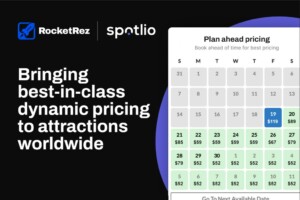By Adam Catterall, Attractions.io
Whether you’re installing a new coaster, building enclosures at your zoo, or just trying to attract more people to your park, every choice you make relies on a steady stream of reliable data. It’s the magical dust that turns a business risk into an informed decision.
It’s not always easy to collect rich guest data. In the last few years, attitudes to data privacy have rightfully changed–and guests are more wary of their digital footprint. 86% of consumers want to know exactly how their data is being used before giving you permission to collect anything.
Yet, while people remain cautious, there’s also another trend emerging. 70% of consumers are more willing to share data if they knew it would improve their experience. This is an example of a value exchange.
What is the value exchange?
Coined in the economics world, the value exchange is a transaction. Simply put, you’re exchanging something of value for your guests for something that’s valuable to you.
We experience value exchanges all the time during our daily lives. Say you’re buying a doughnut at a doughnut stand. You’re exchanging money for goods or services–in this case, a tasty doughnut.
But, things are a little more complicated when you go beyond financial transactions. In modern times, our personal data serves as a currency we can exchange. And we have more control than ever before over the things we spend our data on. We can offer up our information, buying behaviours, and preferences if we feel the personalised recommendations, tailored content, and efficient service we’d get in return make it worthwhile.
How does the value exchange apply to attractions?
Collecting data is like having an insider’s view of your guest experience. It helps you figure out exactly what your guests enjoy, what excites them, and how they navigate your park.
Armed with this data, you can fine-tune your operations and make informed decisions on improvements. You can increase your ride throughput, construct strategically-placed F&B outlets, and have the right number of staff to keep things running smoothly. This increases your operational efficiency and drives your revenue up. Data isn’t just about numbers—it gives you the strategy guide for crafting the perfect guest experience.
Before the digital age, operators relied on high-level admissions numbers and retail sales to inform their business decisions. However, digital channels changed the data game. Guests are constantly interacting with their mobile devices during their visit, creating rich insights into their behaviour and preferences. This lets you zoom in on your guests’ behaviour, analysing how they interact with features, what influences them to make a purchase, and what makes them want to visit again.
But, to get hold of this actionable data, you need to offer something in return that provides value during their visit. In a recent survey by Salesforce, they found that people were more likely to provide some personal information if they got specific value in return: 51% would do it for discounts, 33% for better content, and 14% for more relevant ads.
How digital channels provide value
Your digital channels—whether that’s your website, newsletter opt-ins, or a guest experience platform—provide value by removing friction in the guest journey and offering them with personalised content based on their interactions with your attraction.
For example, imagine your guests are on board with sharing their precise location with you. In return, you provide custom messaging that’s relevant to their surroundings. You might direct them to rides with shorter lines or give them the heads up on nearby food options when hunger strikes.
From your end as the operator, you’ve got access to all this powerful location info. It decodes exactly how your guests are moving around your park and armed with this knowledge, you’re all set to improve your park operations. You’ll be able to:
- Ease congestion. You’re smoothly managing the ebb and flow of people.
- Put staff in the right places, deploying your team where they’re needed most.
- Know the best spots for new F&B or retail outlets. You’re making the smart call, based on where the action is.
It’s more than just sharing information—it’s a win-win where guests get a seamless park experience, and you receive guest data to up your operational performance.
How do you incorporate the value exchange into your attraction?
Building a data strategy helps you in the long-run. You’ll paint a complete picture of how your guests approach a day at your park and what factors impact their satisfaction and loyalty.
A good starting place in building a data strategy is to highlight the types of data you’re currently collecting, and the types you want to supplement it with. Typically, data is broken down into three types:
- Zero-party data. This is the data that your guests share willingly with you. Things like full names, email addresses, and survey answers. It’s often gathered through your admissions process to create accounts.
- 1st party data. This is data you gather about your guests during your interactions with them. This could be things like the demographic they belong to, previous visits, purchases, and how they interact with your digital channels.
- 3rd party data. Finally, third-party data is collected externally to your attraction by other companies. This could refer to general tourism stats or data that your integration partners have on their own user base.
What does a successful data value exchange look like?
Once you’ve taken stock of the data, it’s time to look at what a successful data value exchange looks like. Here are some great examples of how companies offer value in exchange for customer data:
- Tailored recommendations. Streaming giants Netflix keep track of what you watch and how long you watch it for. In return, you get your very own personalised TV guide. This first-party data enables the platform to recommend you things based on your taste and the mood you’re likely to be in.
- Location-based service. Airbnb’s got their customers’ travel needs covered with some location-based know-how. As you search for your ideal stay, Airbnb makes use of your location to show you listings that are nearby. Plus, if you’ve got a particular place in mind, they’ll find the popular spots there too. It’s all about getting tailored results that suit your travel mood, whether it’s a city escape or a snug countryside retreat.
- Sign-up incentives. Shoe-brand legends Nike offer their members 10% off during their birthday month. This gives them access to your personal information, including your age, and in return you’ll receive discounts on your next pair of kicks.
These may be what the top brands are doing, but all of these examples of the data value exchange are achievable by attractions.
Explore your current digital channels and identify where you could offer value. If you have an email newsletter, can you offer guests a discount on admissions to get them to sign up? If your park has a guest experience platform, try sending guests personalised messaging based on where they are in the park, their purchase history, and the time of day.
Fuel your attraction’s success with guest data
Your guests know what they’ve got, and they know you want it. As an attraction, it’s important to recognise the value of data and provide an experience that gives something back. Creating a water-tight data strategy helps you connect every step of your guest journey and provides little incentives that keep your guests coming back for more.
If you’ve already got data processes in place and want to take them further, consider how you can enhance them with new technology. Attractions.io’s head of product, Peter O’Dare will be on the expert panel at IAAPA Expo Europe for the talk Tech Lab: Digital, Data-Driven Personalisation. The panel will be exploring how data-driven, customer-centric technology can boost experiences across the entire guest journey. Find out more here.












